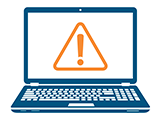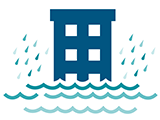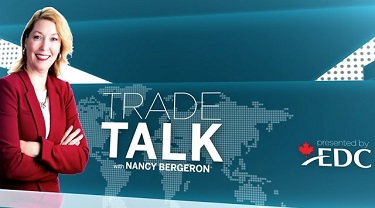As any exporter knows, doing business in international markets always comes with risks. The hazards can range in scale from an economic crisis in a country where you’re operating, down to a company-level shock like the cancellation of a big foreign contract.
Risk levels are fairly low in stable markets such as the United States and much of Europe, while in developing economies they tend to be higher. Even in relatively safe markets, though, it’s prudent to monitor your risk exposure, simply as a matter of good business practice. And if you’re planning to enter a new overseas market, your preparations should always include a careful review of the types of risk you’re likely to face.
“At the global level,” says EDC Economist Andrea Gardella, “some kinds of risk are more common and potentially more severe than others. My top list would include the following hazards, roughly in order of importance.”

A general fall-off in global demand for an exporter’s products can be triggered by any number of factors and can be more or less severe depending on your industrial sector. Sometimes these contractions are abrupt and largely unexpected: one example would be the slump in world oil demand, which has affected not only oil producers but also the service businesses and equipment manufacturers that support them.
In other cases, the onset of the contraction may be slower and easier to foresee, allowing you to mitigate your risk by finding alternative markets or changing your product offerings. If the slowdown is local or regional, finding markets elsewhere in the world may be the best strategy.
As we saw during the 2008–2009 downturn, unstable financial markets can also threaten exporters by making it harder and/or more expensive to obtain credit. This can affect your ability to grow internationally, or even to maintain your position in your existing markets. As the effects of financial instability ripple through countries’ economies, moreover, demand falls, unemployment rises, business confidence suffers and recovery, even when it comes, may be slow and uneven.

“These risks can be important for Canadian exporters,” says Gardella. “On the contract side, suppose your overseas customer suddenly decides to cancel a sale. Moreover, they refuse to abide by any of the clauses in your contract that were meant to penalize such a cancellation. In a market that lacks strong legal tools for enforcing contracts, this can be a real danger for an exporter.”
Other types of legal uncertainty, like complex laws that are unpredictably applied, also belong in this risk category. So do dangers such as arbitrary or unexpected legislative changes—for example, when a government changes the rules that apply to foreign investment, or to currency transfer or conversion. Another significant risk can be the arbitrary imposition of trade barriers like new product standards that apply only to goods from abroad.

“This is also an important risk area,” says EDC Environmental Advisor Kayleigh Grieve. “One particular danger, for example, can be damage to your brand or reputation. Brand damage could result from defects in your goods leading to major product recalls, while reputational damage can arise from things like being associated—even unknowingly—with corruption or bribery. Also in the CSR category are risks flowing from environmental and social concerns, such as causing pollution or engaging in questionable labour practices.”

The overarching hazard here is a perennial one—it’s simply the pressure on your margins that is exerted by competitors, both in your local export market and beyond it. Your competitive edge can also be threatened if you’re operating in a niche market and a large company, taking advantage of its economies of scale, decides to confront you in that market.
Loss of your intellectual property (IP) can also play into the risk of increased competition. This can happen, for example, if a competitor reverse engineers your proprietary technology in order to reproduce it at a lower cost, or even steals your IP outright. IP risk is a particular hazard for information technology companies, but it can be a danger for any exporter whose competitiveness depends on the inherent value of its IP.
As a result of demographic and growth pressures, the global demand for top talent is likely to exceed the supply in both the near and long term. For exporters, and indeed for the business world as a whole, this will make attracting qualified staff both more difficult and more expensive.

An associated risk is talent poaching, which leads to the loss of highly trained workers and their expertise as they move to competing firms. If these workers are familiar with the exporter’s proprietary technology, the risk of IP loss also increases. Another hazard is a sometimes-limited local talent pool. This can force foreign companies to hire from abroad, which increases both costs and the time needed to put workers in place.

At its most obvious, this is the failure to adapt products to changing markets and/or to create new ones as old designs lose their appeal. Occasionally the risk rears its head quite abruptly, for example when a company brings a radically new technology to the market and makes its competitors’ products or services obsolete almost overnight. More often, though, a company’s innovation risk increases over time if it neglects to monitor the marketplace, doesn’t bother to adapt to changing customer needs and fails to develop new products or services.
A less obvious form of this risk, Gardella says, “is to fail to be innovative with your business processes and systems. Innovation in this area can have a direct effect on your productivity, so you need to keep looking for better ways of doing what you do. Innovation is about more than creating new goods and services—it’s also about finding new efficiencies and technologies that will allow you to become more productive.” This also applies to country-level productivity as it is influenced by logistics, transportation, connectivity and the costs of doing business within the country. All these elements can directly affect your bottom line and your ability to grow your business in that market.

In this category are risks such as industrial accidents, computer systems failure (possibly from hacker or malware attacks) and events such as major power outages or sabotage threats. Companies without contingency plans for dealing with such events are at a significantly higher risk than businesses that are well prepared.

Third-party liability refers to injury, loss or damage caused to a third party as a result of your company’s action, inaction or negligence. Depending on where you’re doing business, this can range from a relatively minor risk to a substantial one. In the highly litigious U.S. market, for example, third-party liability can be a major issue for Canadian companies. The risk level is also rising elsewhere: in the EU, it is becoming easier for third parties to undertake collective litigation against corporations and their officers.

These are events that destabilize the local business environment, such as civil unrest, protests, war, revolution and political violence. Such events can prevent your customers from taking delivery of your goods or completing their contracts, or keep them from paying you. You may also lose your equipment and inventory in the country. If you have an affiliate in the market, it may be destroyed or you may have to abandon it as a result of the upheavals.

This covers the impact on key company facilities from risks external to the business, like major natural disasters. Flooding caused by typhoons, for example, falls into this category and can lead to lost production and/or logistics problems. This risk is aggravated if you don’t have effective disaster plans in place.
EDC uses a range of measurements to assess the overall risk of doing business in a particular market. They fall into the categories of short-term risks and medium- to long-term risks, as follows:
Short-term commercial risks
- Risk rating: The average default rate, on credit commitments of one year or less, by commercial borrowers in the country.
- Payment experience: This can be positive, neutral or negative, according to the amount and number of insurance claims made in one year by EDC clients in the country, relative to EDC’s growth in business volume in that country.
Medium- to long-term commercial risks
- Country Commercial Ceiling (CCC): The best possible rate that can be assigned to local customers of EDC clients. Among the factors affecting the CCC are the sovereign probability of default and political risks such as expropriation.
- Expropriation: The likelihood, over the medium to long term, of government interference that may lead to loss of the exporter’s property rights.
- Transfer and conversion: The likelihood, over the medium to long term, of the government imposing transfer or conversion restrictions that prevent exporters or their affiliates from moving their profits back to Canada.
- Political violence: The likelihood, over the medium to long term, of political violence (such as insurrection, terrorism or civil disturbance) that has major effects on the country’s business environment.
- Sovereign default: The likelihood, over the medium to long term, of a sovereign government failing to honour its financial obligations.






